
During August 2007, the Joneses spent 3 glorious weeks exploring the unique landscapes and cultures of Australia, from the south to the center to the north. These tours had been organized as sidetrips from the 27th annual International Puzzle Party, held in Gold Coast, Australia.
The Aussie committee, headed by Frans DeVreugd (Netherlands), had laid out a fantastic program of additional tours and sightseeing, and engaged a most engaging tour guide, Trevor Griffiths, to manage the road trips, lodgings, outings and food. With his Aussie slang and twang he was most entertaining and informative, as were the bus drivers who took us through the Outback and up to the Great Barrier Reef.
Dick took over 600 photos of fascinating places and moments. Here are a selected few, with Kate's personal commentary. For more information about any of the features and history of Australia, please consult authoritative sources, such as Wikipedia.
Sydney — From our room at the centrally located The Menzies hotel, we spent four days walking everywhere, except for one short ride on the Monorail. It's a beautiful city, well designed right down to the manhole covers and guard rails, with shapely skyscrapers and a fondness for round buildings. With its multiple harbors and hilly terrain, there's just about nowhere a level piece of ground. The buildings are stacked, their diversity somehow adding up to a conglomeration that works.

View from top of tower onto downtown Sydney, with the domed Queen Victoria palace that's been converted into a ritzy shopping mall, and the monorail track snaking above the street.

Interior of Queen Victoria mall, with multi-level walkways and an entrance to
the trains underground. This giant clock (one of two different ones)
produces a complex series of sound and motion displays every hour.
Two of Sydney's most famous landmarks: the opera house that looks like a nesting of gigantic shells, and the arched Harbor Bridge. Energetic spirits can do the "bridge climb" on the very top ridge for 179 Australian dollars. We were too late to book for this high-demand stunt and so walked up (for free) countless steps and stairs through backroads and inside buildings to get to the traffic roadbed. It's a lot farther than it looks!
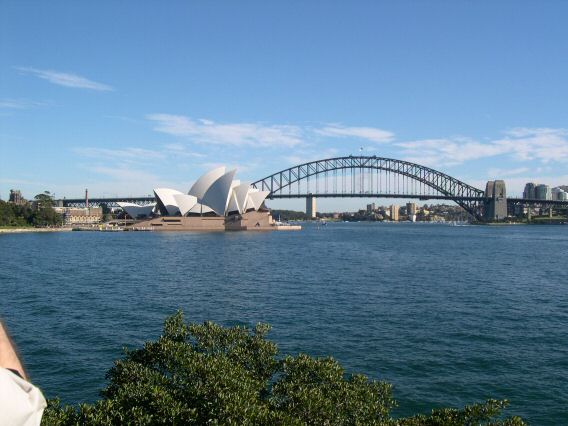
View across harbor to Opera House and the Harbor Bridge. Look closely and you can
see people, tiny as ants, crawling their way along the top of the arch.
The Outback — Most of Australia's interior is semi-arid, with reddish sand and hardy shrubs. Also called the Red Center, it's a place of austere beauty, and where rock formations crop up from the former ocean bottom, it's a magnet for climbers. The red everywhere, we were told, is rust from the iron in the soil. The rocks show where the earth has folded on itself, tipping over at wild angles.
The most famous, and biggest single chunk of stone is Ayers Rock, close to the center of the continent. From a distance it looks like a loaf of bread resting on a table. Viewing it by dawn and sunset are official tour moments, as the sun turns the rock bright pink and orangy red, subtly changing by the minute. See the two shots below.
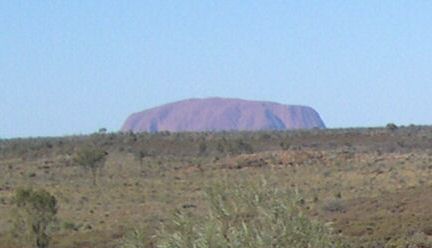
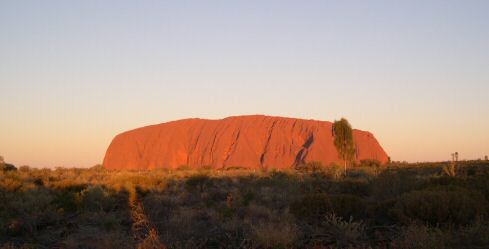
The rock glows with the rising and setting sun.
While some visitors to the Rock made a direct assault up the face, assisted by guy wires, the Joneses and some other folk took the perimeter walk of 9.75 km circling the entire mountain. A few places, such as large caves, are considered holy sites by the natives, and entering and photographing are forbidden. Even climbing the rock is disapproved of but not barred. As we circled, the light and surface features kept changing. The slanting sun made the rock glow as with an inner light.

The rock face is smoothly eroded, with pockets left by underground bubbles
before that part was pushed upward by earth movements.
Other rocky climbs in the area were part of our itinerary, and we show here some of the most dramatic vistas. Of course, that meant some strenuous climbing to the top first! The high plateaus gave great views out over the vast emptiness.
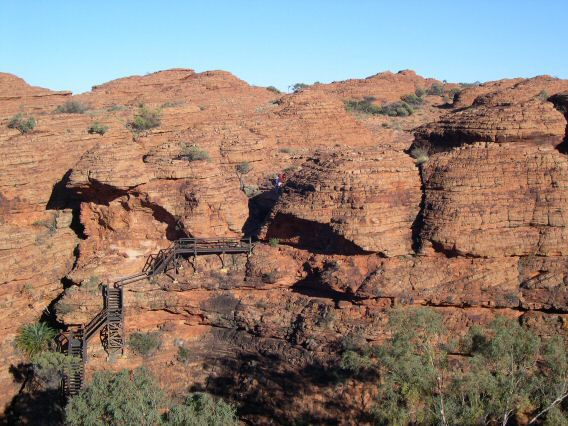
King's Canyon leads to a plateau of dome-like formations after a hefty scramble.
Wooden steps assist in vertical descents.
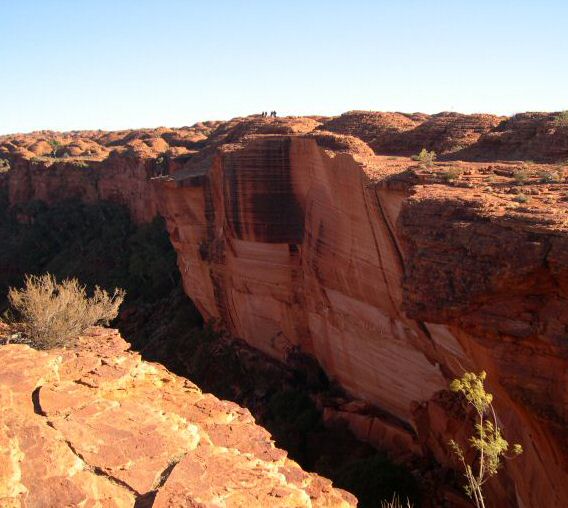
Sheered-off wall faces expose striations, hints of a violent planetary past — a geologist's smorgasbord.
The Blue Mountains near Sydney have awesomely grand formations, many with legends attached. These three columns are called the "Three Sisters". The valley is reached by a dizzyingly steep mining train, and a cable car brings you back out after a goodly hike through the valley.

Three Sisters rock columns in the Blue Mountains, where the air is fresh and the food is fabulous.
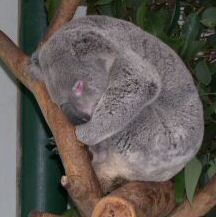 Critters — Australia is famous for some unusual animals, many of them marsupial, and for having 9 of the 10 most poisonous snakes in the world. We visited several zoos and wildlife preserves — Steve Irwin's Australia Zoo, Featherdale Wildlife Park, Alice Springs Desert Park — and saw kangaroos, wallabees, echidnas, dingoes, wombats, Tasmanian devils, huge crocodiles, tigers, camels, elephants, tiny penguins, koalas, emus and other exotic birds, and more. Many are nocturnal, so visits are in the dark. Here are a few encounters:
Critters — Australia is famous for some unusual animals, many of them marsupial, and for having 9 of the 10 most poisonous snakes in the world. We visited several zoos and wildlife preserves — Steve Irwin's Australia Zoo, Featherdale Wildlife Park, Alice Springs Desert Park — and saw kangaroos, wallabees, echidnas, dingoes, wombats, Tasmanian devils, huge crocodiles, tigers, camels, elephants, tiny penguins, koalas, emus and other exotic birds, and more. Many are nocturnal, so visits are in the dark. Here are a few encounters:
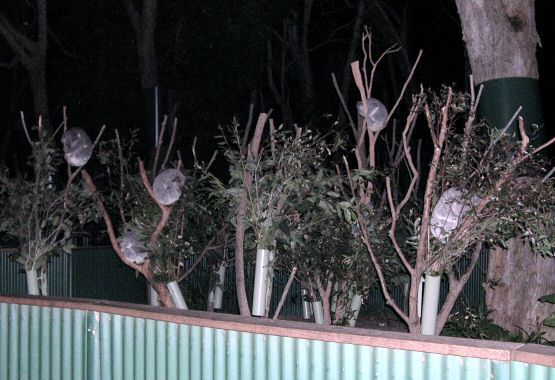
Koala bears hang out in eucalyptus trees, sleeping tucked into a forked branch.
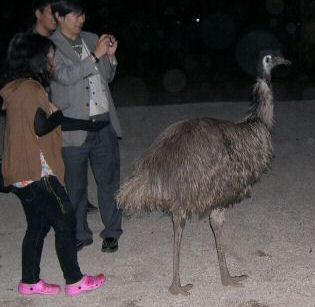
Emu parades calmly among human visitors
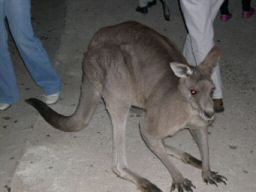
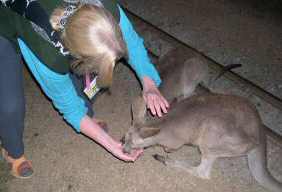
Left—The large "alpha male" kangaroo cautiously tolerates human visitors. Right—Kate handfeeds a young kangaroo; dozens of 'roos roamed freely throughout the park.
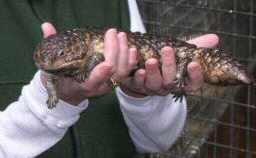
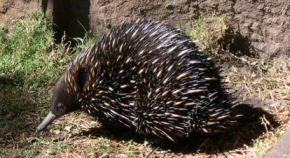
Left—Kate holds a plated lizard; for camouflage its tail looks like its head, and even its hindlegs can rotate to look like front legs. Right—The echidna is marsupial, has a hose-like proboscis to suck up liquids and ants, and its hedgehog-like quills are more like feathers. Nature's whimsy?
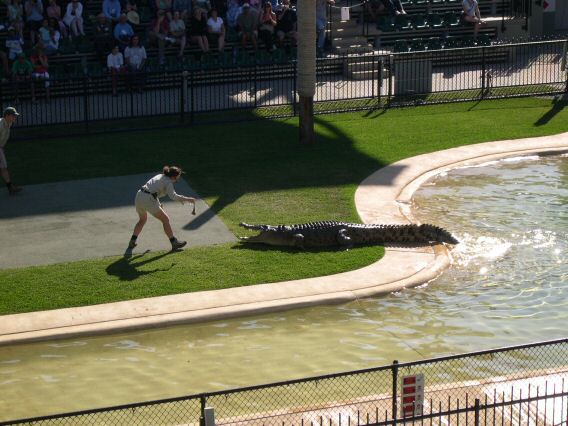
A dangerous job — the handler coaxes a huge crocodile to come out of the water.
A minute later he was chasing her as she darted to safety.
Rainforests — After experiencing the rocky terrain of the Blue Mountains and the dustbowl of the Outback, we went by train to the northernmost parts of Australia, Cairns and the Great Barrier Reef. Closer to the Equator, this area is warm, humid, and covered with rainforests. Fantastical trees and plants have made themselves at home here. We found these most remarkable:
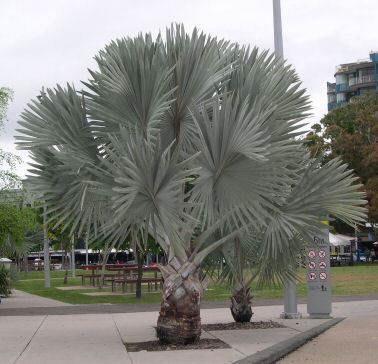
On the streets of Gold Coast, Australia's premier beach resort,
amazing trees like this palm flourish.

On the streets of Cairns, enormous trees with aerial roots. Or is that a parasite growing on its host?
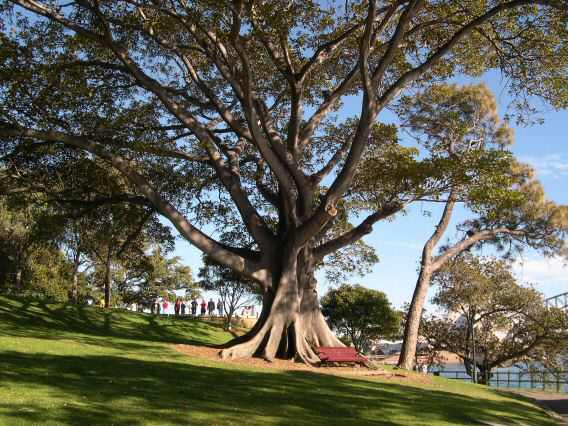
In a park in Sydney, overlooking the harbor, this ancient tree shelters a bench and keeps the secrets.
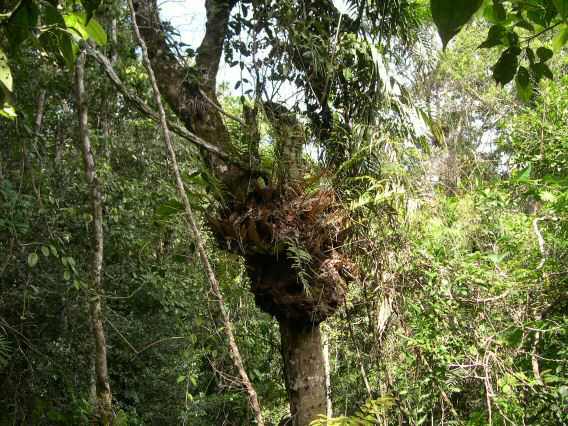
On a walking tour of a section of rainforest near Cairns, symbiotic growths in high branches
are common. Some plants never touch the ground.
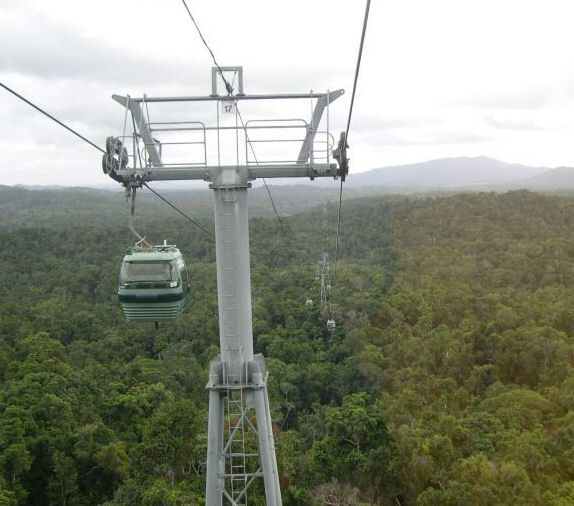
Queensland Railway runs the world's longest cable car ride (40 minutes) near Cairns, with rainforest spreading as far as the eye can see.
Aborigines — Australia's original peoples have tried to preserve some of their ancient cultural forms and beliefs, if only in museums and tourist attractions. Their art is strangely pleasing, with strong geometric elements. Metaphor and symbolism play big parts in imagery, stories, legends and dance. Special shows are staged in which didgeridoo-playing features prominently. (Only the men are allowed to play these instruments.) Galleries and shops promote aboriginal artists' work. Here are some samplings of decorative styles:
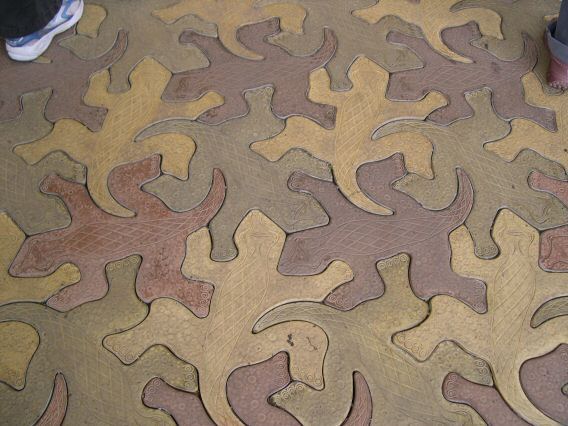
A surprising lizards tessellation in the courtyard and entrance of
the Tjapukai Theatre. Was M.C. Escher here?
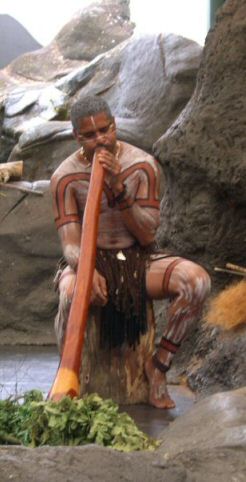
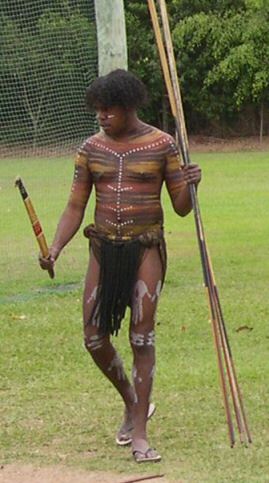
Left — Decorated with body paint, an Aboriginal artist performs on his didgeridoo.
The best instruments are logs naturally hollowed out by termites.
Right — A ceremonially painted performer gives spear-handling lessons.
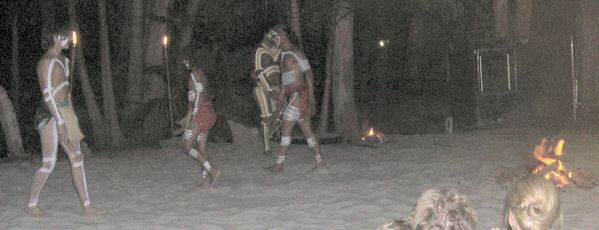
Ritual dances performed around campfire. Between the dust kicked up and the smoke,
Kate came down with bronchitis the next day.
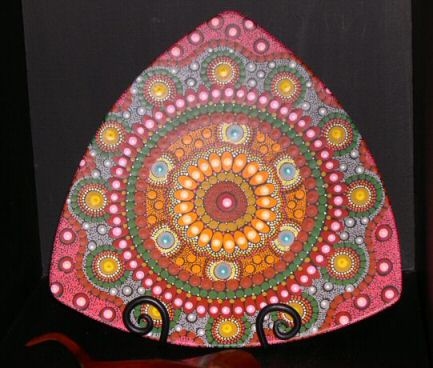
A superb example of native art. Wouldn't it make a great gameboard?
The Great Barrier Reef — Cairns is a growing center of beach resorts and modern skyscrapers. A boat ride took us out to a floating pontoon platform from which visitors could safely see a small part of the carefully protected Reef.
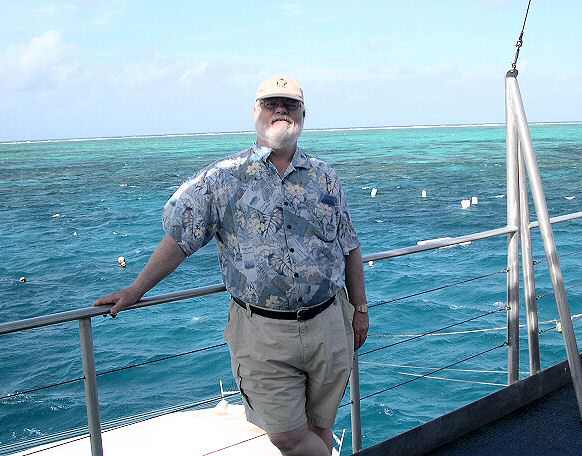
Dick Jones aboard the Reef-viewing vessel.
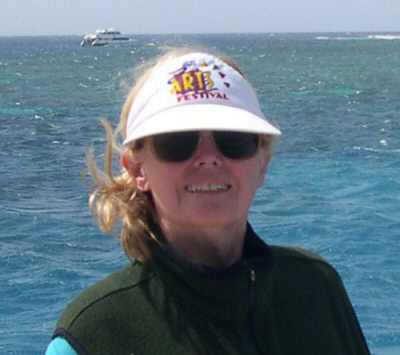
Kate Jones aboard the Reef-viewing vessel. Seeing the Reef was one of the high points
of being
south of the Equator, along with spotting the Southern Cross.
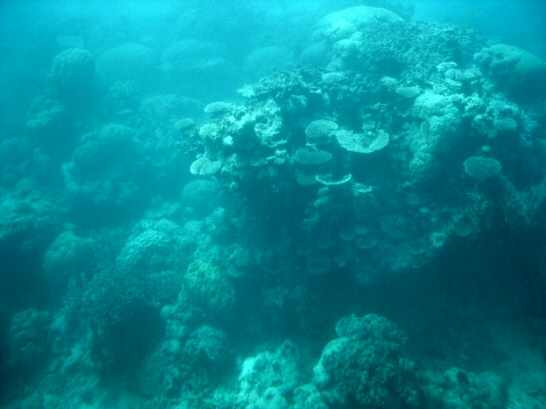
From glass-bottom boat that toured a length of the Reef, a world of breathtaking formations came alive.